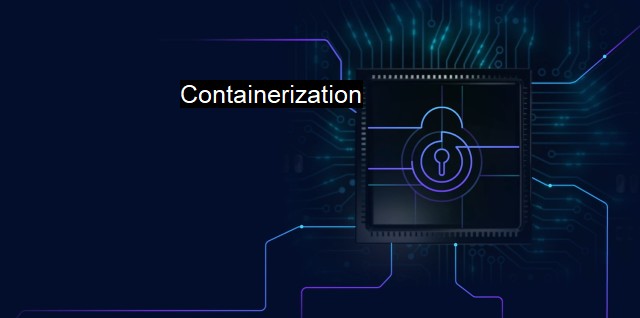What is Containerization?
Containerization: Advancing Cybersecurity and Antivirus with Isolated Compute Environments
Containerization is a technology widely used for software development, cloud computing, and cybersecurity that allows software, application dependencies, services, and computing environments to be packed together in an easily deployable and compact unit known as a container.The concept behind containerization derives essence from its applicability in physical goods transportation. Large shipping containers packed with goods are independent, sturdy, and can be moved onto different vehicles without impacting the integrity of the items inside. Similarly, in the software world, a container is self-sufficient unit that brings together everything a software application requires to run.
In the context of cybersecurity and antiviruses, containerization plays an essential role in preventing and minimizing security breaches in applications, systems, and networks. It divides an application's ecosystem into isolated units, thereby limiting an attacker's movements within small locales should they attempt unauthorized access.
The advantages of containerization for cybersecurity practices are multifold. First, containerization fosters an environment where each application has its own dedicated operating system and resources, thus reducing its dependencies. Through containerization, vulnerabilities that usually arise due to software dependencies can vastly be minimized which results in an augmented security level.
Second, when containers are properly managed and orchestrated, it simplifies version control and accelerates deployment, and more importantly, it segregates applications from the main operating system. Even if an application is compromised, the malware or attacker will not be able to affect an entire system thanks to the isolation offered by the container. This way, containers limit the malware’s lateral movement, creating another line of defense against major system disruptions.
Containerization also makes it possible to implement a "micro-segmentation" model which substantially raises the bar for unauthorized processes, either internally or externally propagated, to navigate through the network architecture. Network segments can limit the scale of applicability of any risk imposed, confining them within their containers. The vulnerability of one application will not transmit itself to another, ensuring that even if one security barrier is overridden, others would remain intact thereby reducing overall security risk.
Deployments via containers can be set up with specific user privileges, thereby limiting breach opportunities for attackers. This has turned out to be quite a major benefit of containerization, manifested in seamless security management and much finer control over user permissions resulting in solidifying the defence mechanism.
Containers work well with DevOps approaches that stress continuous integration/continuous deployment (CI/CD) pipelines. This speeds up the algorithmic vulnerability detection process. With containerization, updating security features or patching vulnerable points becomes a straightforward task since one can simply replace a faulty container with a new, secure one. Undisrupted by geographies or the size of the server, this flexibility and immediacy protects against zero-day attacks, minimizing potential responses times.
In spite of the multiple benefits of containerization, it is crucial to realize that just like any forms of technologies; this too comes with its inherent risks. Containers do not eliminate the need for conventional security measures and antivirus software to effectively deal with external threats. A well-designed two fold security strategy stems by first treating each container as if it were a standalone device planned within a broader, interconnected network ecosystem, subsequently integrating preventative measures like firewalls, malware protection, and regular software updates into the security mix.
Containerization offers a compelling model for cybersecurity as it delivers amplified layers of security while enabling swift responses to threats. Leveraging containerization can help create better sandboxing within applications reducing opportunities for cybersecurity breaches. It has, therefore, increasingly become part of cybersecurity tool-kit, revolutionizing the landscape of system, network, and application security. While complementing traditional security measures, it does entail complexities which should be addressed to ensure their use leads to increased rather than compromised security.

Containerization FAQs
What is containerization in cybersecurity?
Containerization in cybersecurity is a process of packaging an application with all its dependencies and libraries into a single container. It enables the application to run in an isolated environment and allows for secure sharing of resources without affecting the host system.How does containerization enhance antivirus protection?
Containerization enhances antivirus protection by isolating the application from the host operating system. Antivirus software can be deployed inside the container, which monitors and detects any malicious activity. If any malware is detected, it is contained and prevented from further spreading to the host system.What are the benefits of containerization for security?
Containerization offers several benefits for security, including improved isolation, reduced attack surface, and enhanced consistency. It provides a secure environment for applications to run and ensures that any vulnerabilities or misconfigurations in one container do not affect the others. Additionally, it enables security teams to deploy security tools inside the container, which can be customized and managed centrally.Can containerization help with compliance requirements?
Yes, containerization can help with compliance requirements by providing a standardized and auditable environment. Containers can be configured and monitored to adhere to specific compliance regulations, such as HIPAA, PCI DSS, or GDPR. Additionally, container orchestration tools allow for automated updates, patching, and auditing, which helps to ensure compliance and reduce the risk of non-compliance penalties.| | A | | | B | | | C | | | D | | | E | | | F | | | G | | | H | | | I | | | J | | | K | | | L | | | M | |
| | N | | | O | | | P | | | Q | | | R | | | S | | | T | | | U | | | V | | | W | | | X | | | Y | | | Z | |
| | 1 | | | 2 | | | 3 | | | 4 | | | 7 | | | 8 | | |||||||